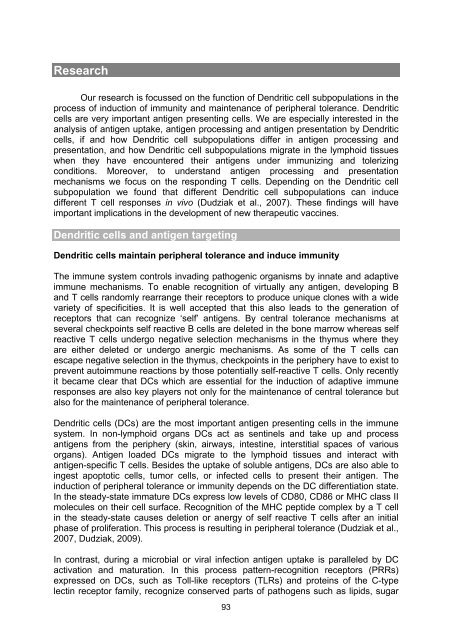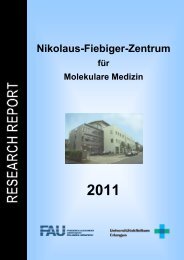Research Report - Nikolaus-Fiebiger-Zentrum für Molekulare Medizin
Research Report - Nikolaus-Fiebiger-Zentrum für Molekulare Medizin
Research Report - Nikolaus-Fiebiger-Zentrum für Molekulare Medizin
Create successful ePaper yourself
Turn your PDF publications into a flip-book with our unique Google optimized e-Paper software.
<strong>Research</strong><br />
Our research is focussed on the function of Dendritic cell subpopulations in the<br />
process of induction of immunity and maintenance of peripheral tolerance. Dendritic<br />
cells are very important antigen presenting cells. We are especially interested in the<br />
analysis of antigen uptake, antigen processing and antigen presentation by Dendritic<br />
cells, if and how Dendritic cell subpopulations differ in antigen processing and<br />
presentation, and how Dendritic cell subpopulations migrate in the lymphoid tissues<br />
when they have encountered their antigens under immunizing and tolerizing<br />
conditions. Moreover, to understand antigen processing and presentation<br />
mechanisms we focus on the responding T cells. Depending on the Dendritic cell<br />
subpopulation we found that different Dendritic cell subpopulations can induce<br />
different T cell responses in vivo (Dudziak et al., 2007). These findings will have<br />
important implications in the development of new therapeutic vaccines.<br />
Dendritic cells and antigen targeting<br />
Dendritic cells maintain peripheral tolerance and induce immunity<br />
The immune system controls invading pathogenic organisms by innate and adaptive<br />
immune mechanisms. To enable recognition of virtually any antigen, developing B<br />
and T cells randomly rearrange their receptors to produce unique clones with a wide<br />
variety of specificities. It is well accepted that this also leads to the generation of<br />
receptors that can recognize ‘self’ antigens. By central tolerance mechanisms at<br />
several checkpoints self reactive B cells are deleted in the bone marrow whereas self<br />
reactive T cells undergo negative selection mechanisms in the thymus where they<br />
are either deleted or undergo anergic mechanisms. As some of the T cells can<br />
escape negative selection in the thymus, checkpoints in the periphery have to exist to<br />
prevent autoimmune reactions by those potentially self-reactive T cells. Only recently<br />
it became clear that DCs which are essential for the induction of adaptive immune<br />
responses are also key players not only for the maintenance of central tolerance but<br />
also for the maintenance of peripheral tolerance.<br />
Dendritic cells (DCs) are the most important antigen presenting cells in the immune<br />
system. In non-lymphoid organs DCs act as sentinels and take up and process<br />
antigens from the periphery (skin, airways, intestine, interstitial spaces of various<br />
organs). Antigen loaded DCs migrate to the lymphoid tissues and interact with<br />
antigen-specific T cells. Besides the uptake of soluble antigens, DCs are also able to<br />
ingest apoptotic cells, tumor cells, or infected cells to present their antigen. The<br />
induction of peripheral tolerance or immunity depends on the DC differentiation state.<br />
In the steady-state immature DCs express low levels of CD80, CD86 or MHC class II<br />
molecules on their cell surface. Recognition of the MHC peptide complex by a T cell<br />
in the steady-state causes deletion or anergy of self reactive T cells after an initial<br />
phase of proliferation. This process is resulting in peripheral tolerance (Dudziak et al.,<br />
2007, Dudziak, 2009).<br />
In contrast, during a microbial or viral infection antigen uptake is paralleled by DC<br />
activation and maturation. In this process pattern-recognition receptors (PRRs)<br />
expressed on DCs, such as Toll-like receptors (TLRs) and proteins of the C-type<br />
lectin receptor family, recognize conserved parts of pathogens such as lipids, sugar<br />
93



